Download Sun Worksheets
Click the button below to get instant access to these premium worksheets for use in the classroom or at a home.

This worksheet can be edited by Premium members using the free Google Slides online software. Click the Edit button above to get started.
Download free sample
Not ready to purchase a subscription yet? Click here to download a FREE sample of this worksheet pack.
Resource Examples
Click any of the example images below to view a larger version.
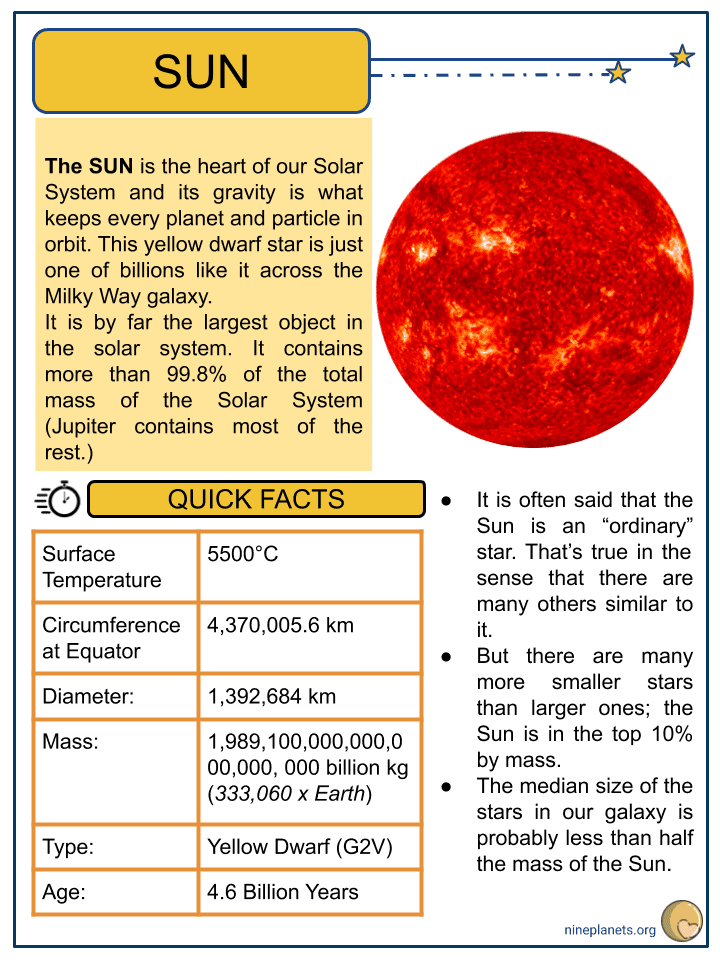
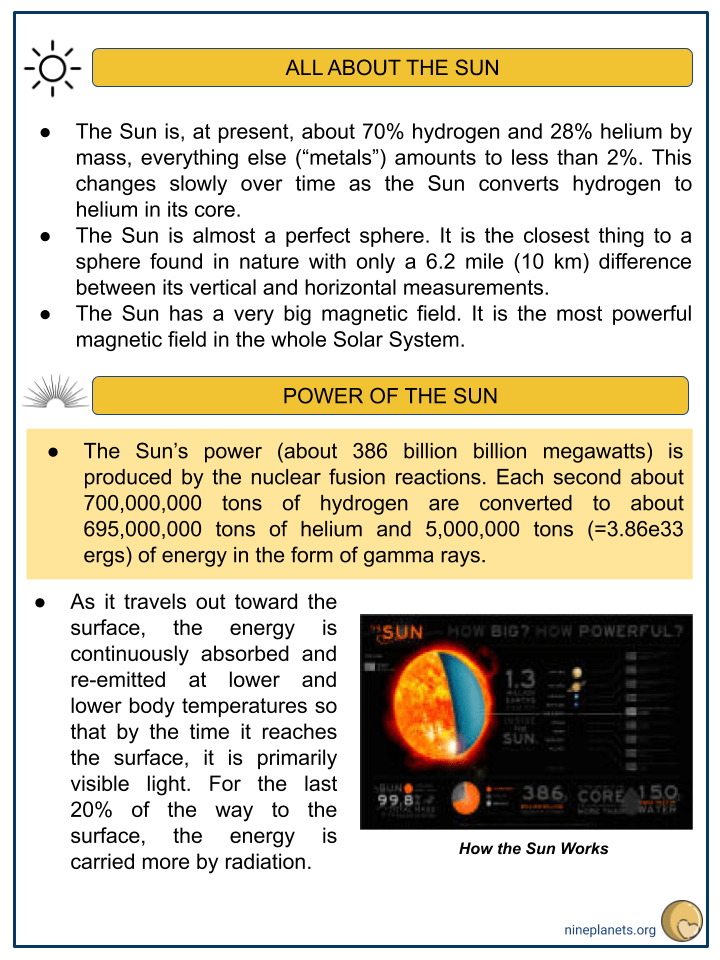
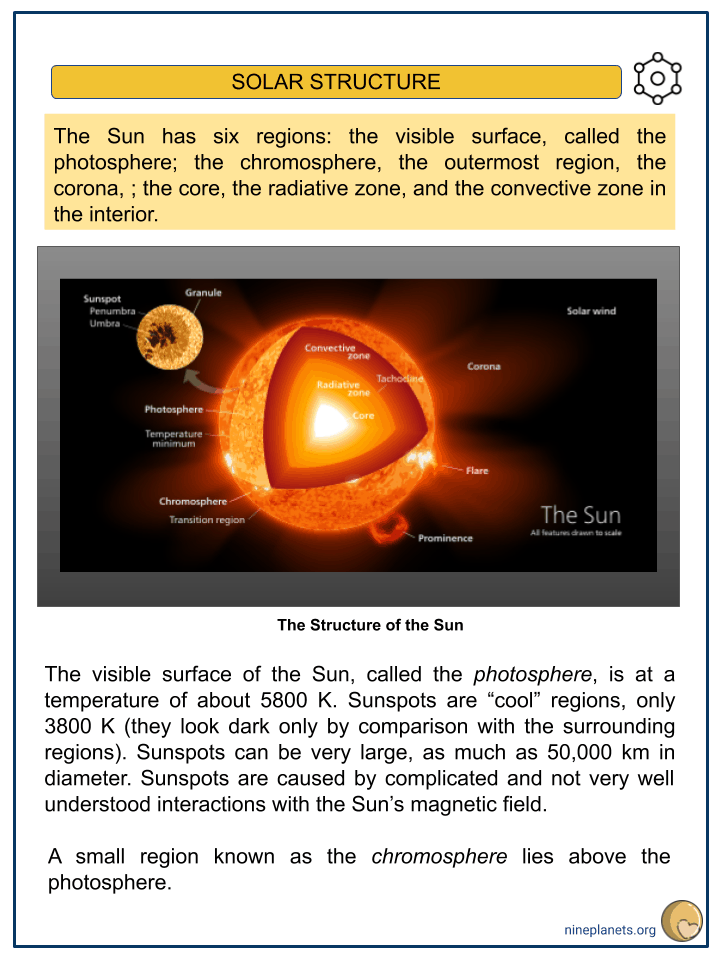
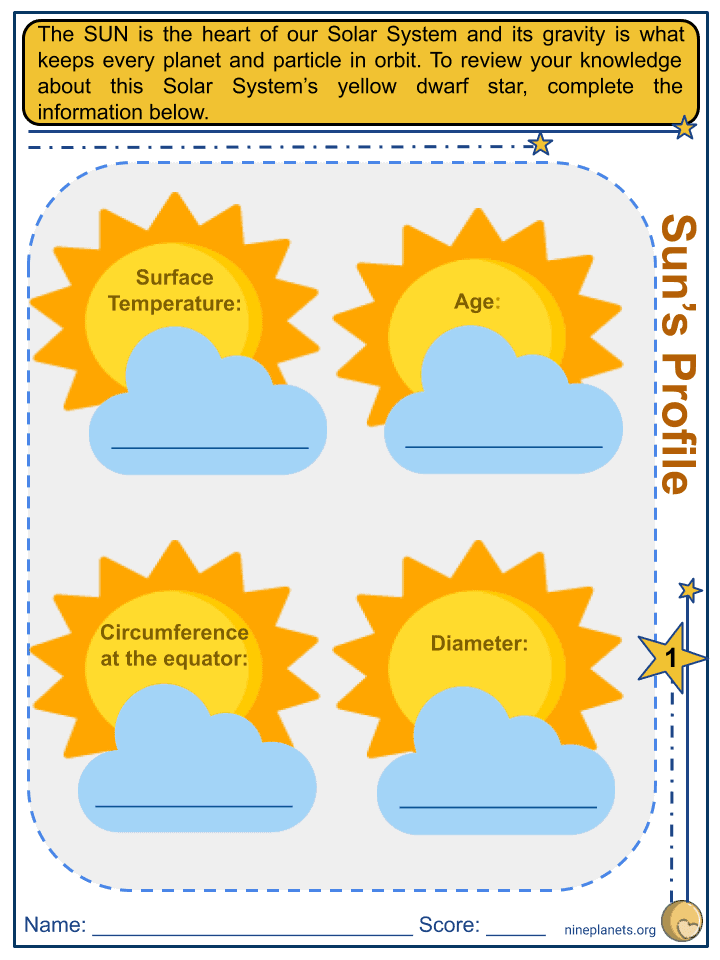
Key Facts & Information
- The SUN is the heart of our Solar System and its gravity is what keeps every planet and particle in orbit. This yellow dwarf star is just one of billions like it across the Milky Way galaxy.
- It is by far the largest object in the solar system. It contains more than 99.8% of the total mass of the Solar System (Jupiter contains most of the rest.)
Quick Facts
- Surface Temperature: 5500°C
- Circumference at Equator: 4,370,005.6 km
- Diameter: 1,392,684 km
- Mass: 1,989,100,000,000,000,000, 000 billion kg (333,060 x Earth)
- Type: Yellow Dwarf (G2V)
- Age: 4.6 Billion Years
- It is often said that the Sun is an “ordinary” star. That’s true in the sense that there are many others similar to it.
- But there are many more smaller stars than larger ones; the Sun is in the top 10% by mass.
- The median size of the stars in our galaxy is probably less than half the mass of the Sun.
All About The Sun
- The Sun is, at present, about 70% hydrogen and 28% helium by mass, everything else (“metals”) amounts to less than 2%. This changes slowly over time as the Sun converts hydrogen to helium in its core.
- The Sun is almost a perfect sphere. It is the closest thing to a sphere found in nature with only a 6.2 mile (10 km) difference between its vertical and horizontal measurements.
- The Sun has a very big magnetic field. It is the most powerful magnetic field in the whole Solar System.
Power Of The Sun
- The Sun’s power (about 386 billion billion megawatts) is produced by the nuclear fusion reactions. Each second about 700,000,000 tons of hydrogen are converted to about 695,000,000 tons of helium and 5,000,000 tons (=3.86e33 ergs) of energy in the form of gamma rays.
- As it travels out toward the surface, the energy is continuously absorbed and re-emitted at lower and lower body temperatures so that by the time it reaches the surface, it is primarily visible light. For the last 20% of the way to the surface, the energy is carried more by radiation.
Solar Structure
- The Sun has six regions: the visible surface, called the photosphere; the chromosphere, the outermost region, the corona, ; the core, the radiative zone, and the convective zone in the interior.
- The visible surface of the Sun, called the photosphere, is at a temperature of about 5800 K. Sunspots are “cool” regions, only 3800 K (they look dark only by comparison with the surrounding regions). Sunspots can be very large, as much as 50,000 km in diameter. Sunspots are caused by complicated and not very well understood interactions with the Sun’s magnetic field.
- A small region known as the chromosphere lies above the photosphere.
- The highly rarefied region above the chromosphere, called the corona, extends millions of kilometers into space, but is visible only during a total solar eclipse. Temperatures in the corona are over 1,000,000 K.
- In the Sun’s interior, there are three main parts; the core, the radiative zone, and the convective zone.
- The core, which is the hottest region is at the center, and where nuclear reactions that power the Sun happen. Located outside the core is called the radiative/radiation zone. This name was derived from thermal radiation, wherein the energy carried by photons is drawn outward through this layer. The last region in the Sun’s interior is named the convective/convection zone. The heat in this layer moves up via roiling convection, which is similar to the bubbling motion in a pot of boiling oatmeal.
Solar Wind
- In addition to heat and light, the Sun also emits a low density stream of charged particles (mostly electrons and protons) known as the solar wind, which propagates throughout the Solar System at about 450 km/sec.
- The solar wind and the much higher energy particles ejected by the solar flares can have dramatic effects on the Earth ranging from power line surges to radio interference to the beautiful aurora borealis.
Sun’s Rotation
- The outer layers of the Sun exhibit differential rotation: at the equator, the surface rotates once every 25.4 days; near the poles it’s as much as 36 days. This odd behavior is due to the fact that the Sun is not a solid body like the Earth. Similar effects are seen in the gas planets.
- Differential rotation in the Sun. The rotation rate is higher at the equator than at the poles. The frequency is measured in mHz and the dashed line represents the base of the convection zone. Taken from Schou et al. (1998).
- The differential rotation extends considerably down into the interior of the Sun, but the core of the Sun rotates as a solid body.
- At the center of the core, the Sun’s density is more than 150 times that of water.
Solar Eclipse
- It just happens that the Moon and the Sun appear the same size in the sky when viewed from the Earth.
- Since the Moon orbits the Earth in approximately the same plane as the Earth’s orbit around the Sun, sometimes the Moon comes directly between the Earth and the Sun, this is called a solar eclipse.
- If the alignment is slightly imperfect then the Moon covers only part of the Sun’s disk and the event is called a partial eclipse.
- When it lines up perfectly the entire solar disk is blocked and it is called a total eclipse of the sun.
- Partial eclipses are visible over a wide area of the Earth, but the region from which a total eclipse is visible, called the path of totality, is very narrow, just a few kilometers (though it is usually thousands of kilometers long).
- Eclipses of the Sun happen once or twice a year. People often travel halfway around the world just to see a total solar eclipse.
Sun’s Satellites
- There are eight planets and a large number of smaller objects orbiting the Sun.
- (Exactly which bodies should be classified as planets and which as “smaller objects” has been the source of some controversy, but in the end it is really only a matter of definition. Pluto is no longer officially a planet, but we’ll keep it here for history’s sake.)
- Below is the tabular information on the planets’ distance from the Sun, their radius, mass, discoverer and the date of discovery.
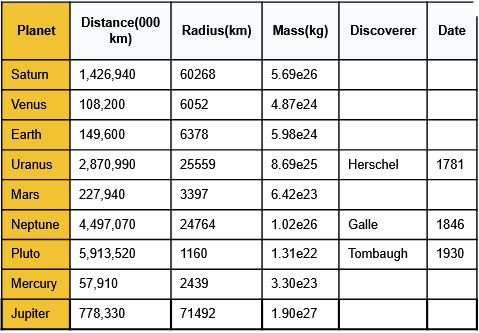
More About Sun
- The Sun is personified in many mythologies: the Greeks called it Helios and the Romans called it Sol.
- The Sun is one of the millions of stars in the Solar System. It is, however, larger than most (although not the biggest) and a very special star to us. Without the Sun there would be absolutely no life on Earth.
- The Sun is so big it takes up 99% of the matter in our Solar System. The 1% left over is taken up by planets, asteroids, moons and other matter.
- The Sun’s core is extremely hot! An unthinkable 13,600,000 degrees Celsius.
- The Sun is the center of the Solar System. It is 92.96 million miles (149.6 km) away from Earth.
- As the Sun ages, it will get bigger. When this happens, it will consume some of the things close to it, and this includes Mercury, Venus and maybe even Earth and Mars. Luckily this is billions of years in the future.
- The Sun produces solar winds. This is why planets’ atmospheres are so important. They protect the planet from these solar winds.
- The Sun has been both worshipped and feared throughout history by a variety of cultures.
- The Sun is the center and the largest object of our Solar System. It is composed of inner and outer layers.
- The Sun is almost a perfect sphere. It is the closest thing to a sphere found in nature with only 6.2 miles (10 km) difference between its vertical and horizontal measurements.